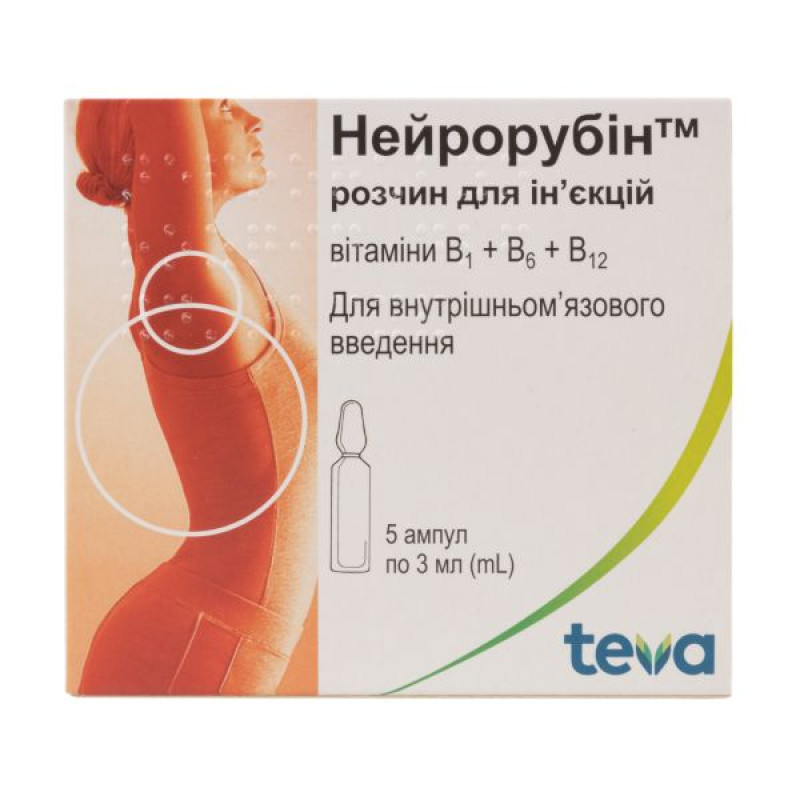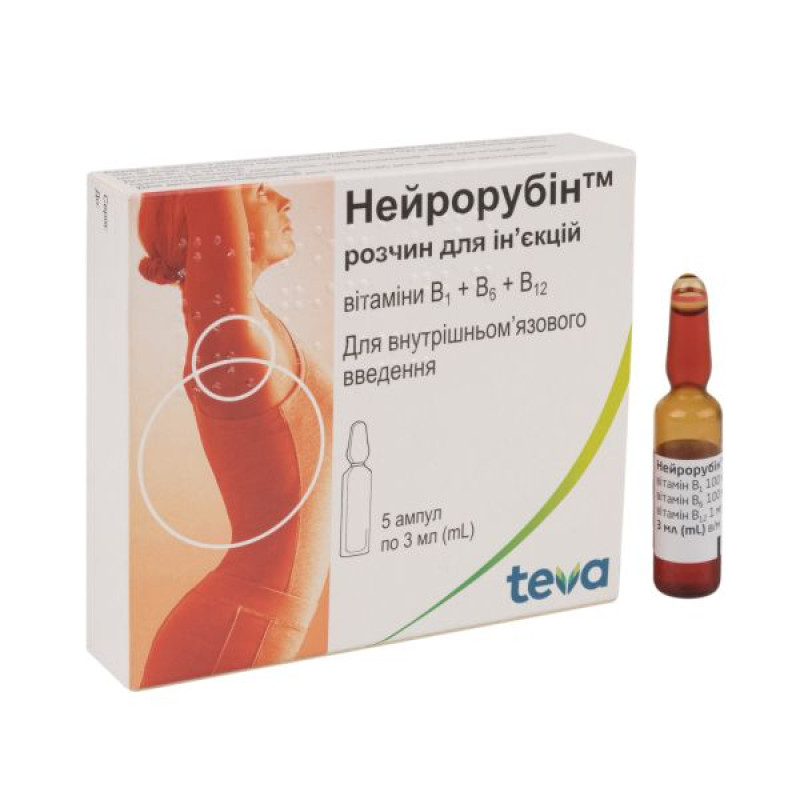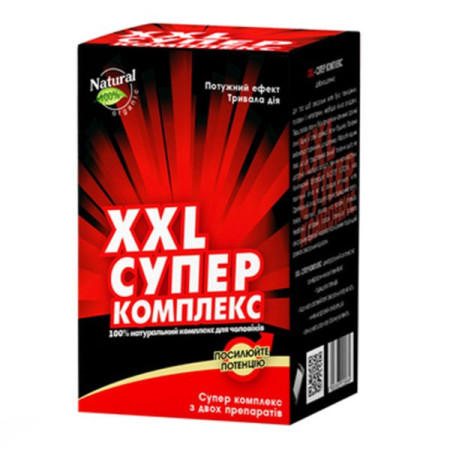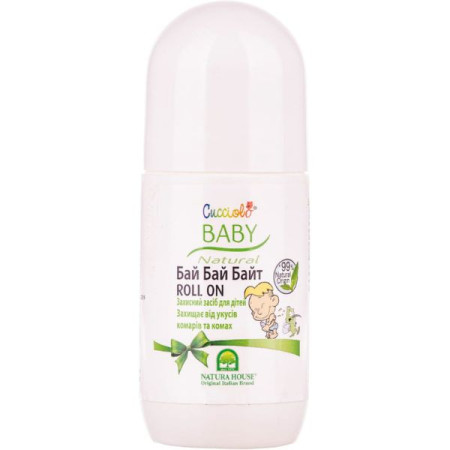Neurorubin solution for injection ampoule 3 ml No. 5
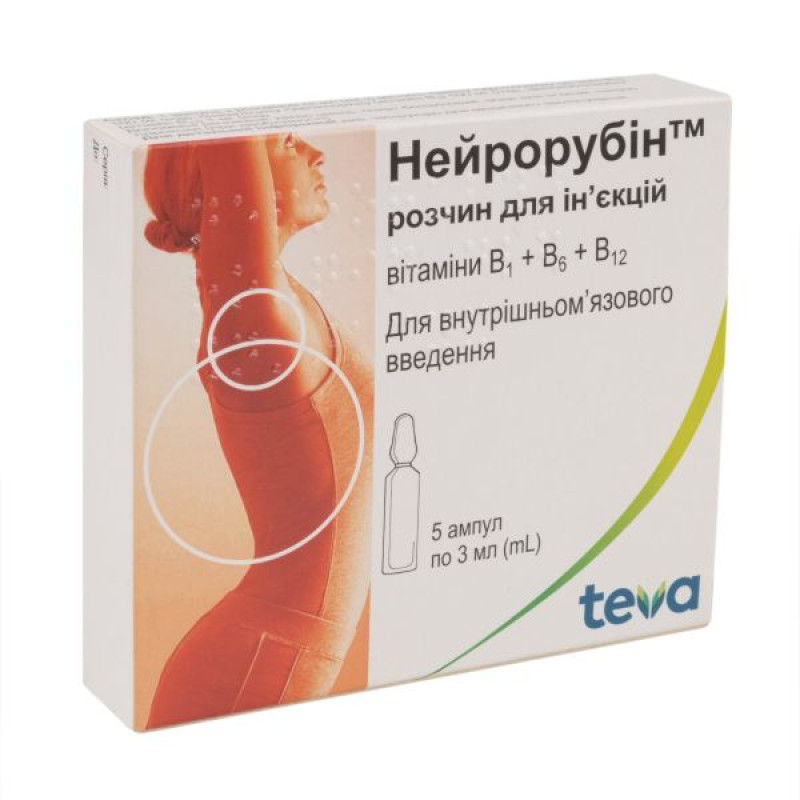
Instructions Neurorubin solution for injection ampoule 3 ml No. 5
Composition
active ingredients: thiamine hydrochloride (vitamin B1), pyridoxine hydrochloride (vitamin B6), cyanocobalamin (vitamin B12);
1 ampoule with solution (3 ml) contains: thiamine hydrochloride (vitamin B1) 100 mg, pyridoxine hydrochloride (vitamin B6) 100 mg, cyanocobalamin (vitamin B12) 1 mg;
Excipients: potassium cyanide, benzyl alcohol, water for injection, sodium hydroxide (if necessary).
Dosage form
Solution for injection.
Main physicochemical properties: transparent, red solution.
Pharmacotherapeutic group
Vitamin B1 in combination with vitamin B6 and/or vitamin B12. ATX code A11D B.
Pharmacological properties
Pharmacodynamics
Neurorubin™ combines high doses of three vitamins: B1, B6, B12, which play an important role in the functioning of the nervous system. Each of these vitamins is necessary for optimal metabolism in nerve cells. In addition, when used in high doses, these vitamins have an analgesic effect.
Like all other vitamins, they are essential nutrients that cannot be synthesized directly in the body.
Therapeutic administration of vitamins B1, B6 and B12 into the body replenishes the insufficient intake of vitamins with food, which ensures the presence of the necessary amount of coenzymes in the body. B vitamins are components of enzyme systems that regulate the metabolism of proteins, fats and carbohydrates. However, each of the B vitamins performs a specific biological role. Their presence in the body in a balanced amount is necessary for normal metabolism.
The therapeutic use of these vitamins in various diseases of the nervous system is aimed, on the one hand, at compensating for the simultaneously existing deficiency (possibly due to an increase in the body's need caused directly by the disease) and, on the other hand, at stimulating the natural mechanisms of recovery. Vitamins B1, B6 and B12 have very low toxicity and do not pose a potential risk to humans. To date, there is no data on the carcinogenic, mutagenic or teratogenic properties of these vitamins.
Pharmacokinetics
Water-soluble vitamins are completely absorbed by the body after intramuscular injection. The degree of absorption depends on the location of the blood flow relative to the injection site.
Cyanocobalamin (vitamin B12). After absorption, vitamin B12 binds in serum to specific B12-binding beta-(transcobalamin) and B12-binding alpha1-globulin.
Vitamin B12 is stored primarily in the liver. The half-life from serum is approximately 5 days and from the liver is approximately 1 year.
Thiamine hydrochloride (vitamin B1). Part of the absorbed thiamine participates in enterohepatic circulation. The main products of thiamine excretion are thiaminecarboxylic acid and pyramine (2,5-dimethyl-4-aminopyrimidine). At the same time, a small amount of thiamine is excreted unchanged.
Pyridoxine hydrochloride (vitamin B6). In the body, pyridoxine is oxidized to pyridoxal or aminated to pyridoxamine. The condition for its functioning as a coenzyme is phosphorylation at the CH2OH group in the 5th position, i.e. the formation of pyridoxal-5-phosphate (PALP). In the blood, about 80% of PALP is bound to proteins. Pyridoxine mainly accumulates in the muscles in the form of PALP. The main excretion product is 4-pyridoxic acid.
Indication
Treatment of neuritis and neuralgia, such as:
intercostal neuralgia; lumbar syndrome (lumbago); plexitis (cervical and brachial plexuses); radicular neuritis due to degenerative diseases of the spine.
As an adjunctive treatment:
trigeminal neuralgia; sciatica.
Contraindication
Hypersensitivity to any component of the drug.
Vitamin B1 is contraindicated for use in allergic diseases.
Vitamin B6 is contraindicated for use in cases of gastric and duodenal ulcers in the acute stage (since increased acidity of gastric juice is possible).
Vitamin B12 is contraindicated for use in erythremia, erythrocytosis, thromboembolism, and psoriasis.
Interaction with other medicinal products and other types of interactions
High doses of vitamin B6, such as those contained in Neurorubin™, may reduce the therapeutic effect of levodopa in Parkinson's disease, except when a decarboxylase inhibitor is used concomitantly.
The toxicity of isoniazid may increase.
Vitamin B6 may decrease the effectiveness of altretamine.
Concomitant use with pyridoxine antagonists (e.g. isoniazid, hydralazine, penicillamine or cycloserine) or oral contraceptives may increase the need for vitamin B6.
The action of thiamine is inactivated by 5-fluorouracil, as the latter competitively inhibits the phosphorylation of thiamine to thiamine pyrophosphate.
Antacids slow down the absorption of vitamin B1.
Loop diuretics, such as furosemide, which inhibit tubular reabsorption, may increase thiamine excretion during long-term therapy and thus reduce its levels.
Application features
Since Neurorubin contains vitamin B6, the drug should be used with caution in patients with a history of peptic ulcer of the stomach and duodenum, severe renal and hepatic dysfunction.
Patients with neoplasms, except in cases accompanied by megaloblastic anemia and vitamin B12 deficiency, should not use the drug.
The drug should not be used in severe or acute forms of cardiac decompensation and angina pectoris.
Continuous monitoring for signs of peripheral sensory neuropathy is recommended during long-term use.
Short-term parenteral use of vitamin B12 may temporarily complicate the diagnosis of funicular myelosis or pernicious anemia.
If signs of peripheral sensory neuropathy (paresthesia) occur, the dosage of the drug should be reviewed and, if necessary, its use should be discontinued.
Cases of neuropathy have been observed with long-term (over 6–12 months) use of vitamin B6 in daily doses of more than 50 mg, as well as with short-term (over 2 months) use of vitamin B6 in doses of more than 1 g per day.
Intramuscular injections of vitamin B12 may cause anaphylactoid reactions in hypersensitive patients.
This medicinal product may contain less than 1 mmol (23 mg) sodium/dose, i.e. essentially sodium-free. This medicinal product also contains less than 1 mmol (39 mg) potassium/dose, i.e. essentially potassium-free.
Ability to influence reaction speed when driving vehicles or other mechanisms
The drug does not affect the ability to drive or operate complex mechanisms.
If dizziness occurs during treatment with the drug, you should refrain from driving vehicles and operating other mechanisms.
Use during pregnancy or breastfeeding
Pregnancy
There are no clinical studies of Neurorubin™ treatment in animals or women during pregnancy. The potential risk to humans is unknown, therefore the drug is not recommended for use during pregnancy.
Breast-feeding
Vitamins B1, B6 and B12 are excreted in breast milk. High concentrations of vitamin B6 may inhibit the production of breast milk. Animal studies on the extent of secretion into breast milk are not available. The drug is not recommended for use during breast-feeding. A decision on whether to discontinue breast-feeding or to discontinue the drug should be made taking into account the benefit of breast-feeding for the child and the benefit of therapy for the mother.
Method of administration and doses
The drug is intended for intramuscular administration.
Dosage
In severe (acute) cases: 1 ampoule per day until the intensity of acute symptoms decreases.
After symptoms subside: 1 ampoule 1–3 times a week.
To maintain or continue the initial therapeutic course of injections and to prevent relapse, it is recommended to use the drug Neurorubin™-Forte Lactab, film-coated tablets.
Do not exceed the recommended daily dose.
The duration of treatment, which depends on the nature and course of the disease, is determined by the doctor.
Application technique.
To open the ampoule:
Hold the ampoule with the dot marking facing up; shake the ampoule until the liquid reaches the bottom; break off the head of the ampoule above the marking.
Children
There is no experience in treating children with this drug, so the drug should not be prescribed to children.
Overdose
Overdose increases adverse reactions.
Vitamin B1
Thiamine has a wide therapeutic range. Very high doses (more than 10 g) have a ganglionic blocking effect and inhibit nerve impulse conduction in a curare-like manner.
Vitamin B6
The toxicity of vitamin B6 can be considered very low.
However, long-term (> 6–12 months) use of vitamin B6 in daily doses exceeding 50 mg may cause peripheral sensory neuropathy.
Continuous use of vitamin B6 in daily doses exceeding 1 g for more than two months may lead to neurotoxic adverse reactions.
When using more than 2 g per day, neuropathies with ataxia and sensory disturbances, cerebral seizures with EEG changes and, in isolated cases, hypochromic anemia and seborrheic dermatitis have been described.
Vitamin B12
After parenteral administration (in rare cases - after oral administration) of the drug in doses higher than recommended, allergic reactions, eczematous skin disorders and benign acne were observed. With prolonged use in high doses, liver enzyme activity disorders, pain in the heart area, hypercoagulation are possible.
Adverse reactions
Immune system disorders: chromaturia, hypersensitivity reactions, including angioedema, anaphylactoid reactions, anaphylactic shock, mainly in patients with hypersensitivity.
On the part of the endocrine system: inhibition of prolactin secretion.
Cardiovascular system: tachycardia, circulatory collapse, mainly in patients with hypersensitivity.
Respiratory system: cyanosis, pulmonary edema, mainly in patients with hypersensitivity.
Gastrointestinal disorders: gastrointestinal disorders, including vomiting, diarrhea, abdominal pain, increased acidity of gastric juice, nausea, bleeding from the digestive tract, mainly in patients with hypersensitivity.
On the part of the hepatobiliary system: high doses of the drug may lead to an increase in the level of glutamine aspartate aminotransferase (AST) in the blood serum.
Skin and subcutaneous tissue disorders: rash, skin hyperemia, eczema, itching, urticaria, mainly in patients with hypersensitivity.
High doses of the drug may cause acne. Pyridoxine hydrochloride may provoke a worsening of acne vulgaris or the appearance of acne lesions.
General reactions and complications at the injection site: reactions at the injection site, increased sweating, weakness, feeling of a "lump" in the throat.
Expiration date
3 years.
Storage conditions
Store at a temperature of 2 to 8 °C (in a refrigerator). Keep out of the reach of children.
Packaging
3 ml in an ampoule; 5 ampoules in a box.
Vacation category
According to the recipe.
Producer
Merkle GmbH.
Location of the manufacturer and its business address
Ludwig-Merkle-Strasse 3, 89143 Blaubeuren, Germany.
There are no reviews for this product.
There are no reviews for this product, be the first to leave your review.
No questions about this product, be the first and ask your question.







